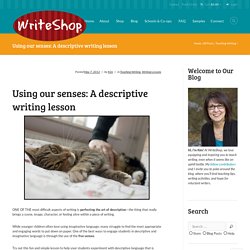

Write a Silly Poem. Describe an Imaginary Place or Strange Land. Summer is a season of travel, a time of sandy beaches, hypnotic sunshine, stamped tickets, and the excited laughter of children visiting out-of-the-ordinary places.

Summer vacations—and the summer months—fill our minds with those moments of wonder and imagination so natural to childhood and keep us connected to our own children. But sometimes the household budget doesn’t stretch quite far enough for exotic adventures. What to do? Go anyway! Here’s how! Start with a Map Gather your family around the kitchen table with paper, pencils, pens, and an atlas.
Set Your Imagination Loose It’s time to describe an imaginary place! What color is the sky? Are there trees or flowering plants? Place yourself there. What kind of person—or wonderful being—could you allow yourself to be there? Create Your World As ideas shape themselves around your kitchen table, have your children create colorful maps and illustrated “travel guides” of their visionary worlds.
Enjoy your magical travels this summer! Using our senses: A descriptive writing lesson - WriteShop. ONE OF THE most difficult aspects of writing is perfecting the art of description—the thing that really brings a scene, image, character, or feeling alive within a piece of writing.

While younger children often love using imaginative language, many struggle to find the most appropriate and engaging words to put down on paper. One of the best ways to engage students in descriptive and imaginative language is through the use of the five senses. Try out this fun and simple lesson to help your students experiment with descriptive language that is unique and full of life and movement. 1. Discuss the Senses It is through our five senses that we experience the world around us. Talk about sight, sound, touch, smell, and taste.Collect words from your students that fall within each category. 2. This is where the lesson gets interesting and fun. Let’s say you gathered some Silly Putty, a fork, and a sharp rock to help them experience their sense of touch. 3.
Describing a food: The good, the bad, and the ugly - WriteShop. The Good I love the deliciousness of certain words—the way something as ordinary as chocolate can take on an entire new personality when dressed up with adjectives like warm, rich, thick, gooey, chilled, creamy, or frothy.

Such descriptive words bring everyday foods to life. Magazine writers, cookbook editors, food bloggers, and restaurant reviewers are experts at describing a food. They definitely know the value of a well-turned phrase! Using appetizing words like simmering, hearty, robust, browned, and spicy, they tempt the reader to try a new recipe or visit an out-of-the-way cafe with enticing offerings like these: The cake looked like a homespun masterpiece.
This cream of mushroom soup hasn’t lost one jot of its butter-laden, cognac-kissed suavity. Plump shrimp, sautéed with chile flakes and served with a salad of oyster mushrooms, cucumber and corn, turned out to be everything I wanted on a Saturday morning: fresh, vibrant and crunchy, with just enough spicy zing to wake me up. A Descriptive Feast for the Senses. “One of the cornerstones of powerful writing is the use of concrete details that can tell your story for you.

I don’t care if you’re writing a sales letter, a blog post or a short story for The New Yorker, you need details.” ~Sonia Simone, Copyblogger.com This article contains affiliate links for products we’re confident your family will love! Concreteness transports us into a story like nothing else. It’s the key that unlocks the door of the reader’s imagination. If your teen’s paper is vague and sketchy, what happens? Choose Words Wisely Concrete writing engages the senses. Robust nouns and active verbs always pack more punch than weak ones that are simply preceded by a string of adjectives or adverbs. Search for Word Pictures It’s fun to ask your students to search for descriptive, concrete passages in the books they’re reading, such as this excerpt from The Fellowship of the Ring by J.R.R. Notice how Tolkien paints a haunting image of Gollum as he makes his wily approach.
Teaching KIds to Write with Vivid Vocabulary. “Descriptive writing is an art form.

It’s painting a word picture so that the reader ‘sees’ exactly what you are describing.”